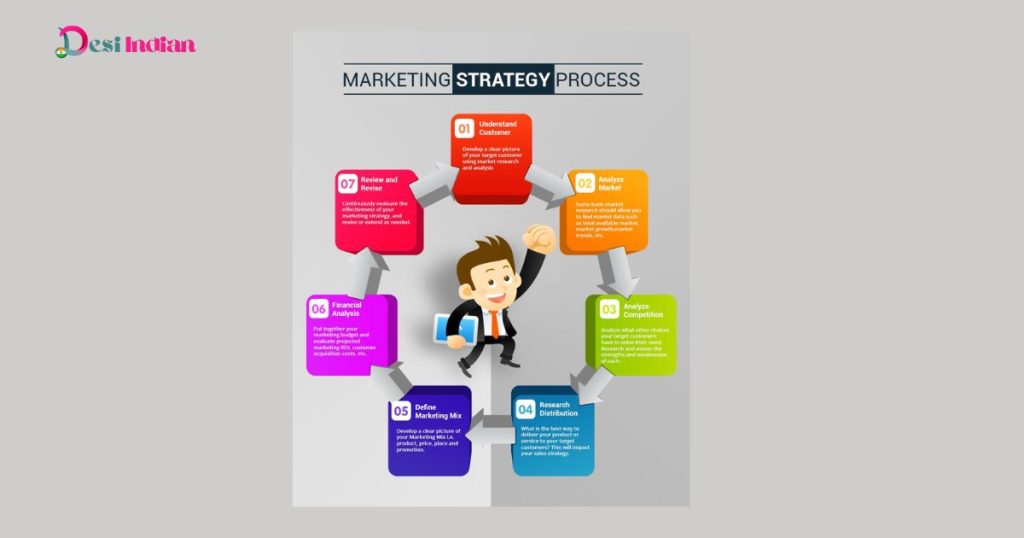
All forms of small businesses cannot succeed without good marketing strategies. Also, marketing strategies involve many marketing types. You can use them to target the market with the products and services. The marketer must consider the 4Ps of marketing — product, price, place, and promotion. They need to use them to create a full marketing plan that fits the company’s needs.
Understanding Marketing Strategies
Marketing strategies include the tasks of social media marketing. They also include market research and using marketing channels. Because of this, the business can market its products and/or services . It does this by using a marketing mix that fits the target market. It also uses strategies like public relations. It uses content and affiliate marketing to stay ahead in the market.
Types of Marketing Strategies
Marketing strategy development is determining a company’s marketing goals. It involves picking a target market. Then, deciding on the needed marketing campaigns to meet the goals. A good marketing strategy will help a company make a successful marketing plan. The plan will state the specific efforts and policies that should be in place. This strategy aims to create a lasting edge. It uses digital marketing, inbound marketing, and direct marketing. It uses other approaches to reach the audience and grow the business.
The 4 Ps of Marketing
Marketing strategies encompass many ways. Companies use them to promote products or services to the target market. It is critical to be familiar with the 4 Ps of marketing: product, price, place, promotion. These are the basics of any well-made marketing plan. It aims to meet the company’s goals and appeal to the target audience.
Understanding the 4 Ps of Marketing
The 4 Ps of marketing are ingredients. The marketer can base their strategies on them. They use them to position and sell their offerings. Product is the physical goods or services provided, while the price is the valuation of the same. Place is the access to the product using distribution channels. Promotion is the marketer’s persuasion strategy to attract a sale from the consumer.
Implementing the 4 Ps of Marketing
The 4 Ps involve analyzing market trends. You must understand consumer needs and behavior. Then, make decisions that lead to the marketing goals. Marketers should use the Ps to tailor products. This will please consumers’ needs and be different from competitor offerings. Companies can align product features, pricing, distribution, and promotion. This creates a compelling marketing mix that resonates with customers.
Importance of the 4 Ps in Marketing
All the 4 Ps shape the strategies of marketing. When used well, they play a major role in building consumer perception. This perception helps boost awareness, engage consumers, and grow sales. The market changes often. The company must also change its 4 Ps according to consumer feedback. This keeps the company competitive and in the market.

Creating a Marketing Plan
Documenting your marketing strategy means putting on paper detailed steps and tactics. They go hand in hand with the successful promotion of products or services. A good strategy should be like a roadmap. It guides marketing to meet business goals. Identifying target markets is important. So is analyzing competitors. And, creating key messages for communication is also key.
Setting Marketing Goals
Set clear, measurable marketing goals. Do this before any marketing starts. A good goal should be specific, attainable, relevant, and time-bound. Clear goals help. They can be for more brand awareness, more leads, or better sales. They guide sound decisions. They are also a basis for checking how well all marketing operations work.
Target Audience Analysis
Knowing the target audience is very basic. It’s key for making a marketing strategy. Thorough analysis of demographics, psychographics, and behavior helps a business. It helps them identify what potential customers desire, like, and what annoys them. Segmenting an audience will let you target messages to a specific group. This will help an organization get more engagement and conversion.
Marketing activities are the key drivers for small business success. Digital marketing revolves around the development and dissemination of products or services through different online platforms and their tools. One can think of everything. From making content to running targeted ads that reach a larger audience.
Another marketing strategy is the use of public relations. This is a way to build reputation and credibility with a brand. It involves liaisons with the media, influencers, and the public. Businesses can do public relations through press releases, events, or partnerships. They use these to tell their identity to the target market.
A content marketing strategy is about creating helpful content. It is also about creating relevant content that can attract and engage the target market. A content plan helps businesses. It lets them share useful blogs, videos, and social media posts. They share these with the target market. These things build the brand. They also establish thought leadership in the industry.
Successful Implementation of Marketing Strategies
Inbound marketing techniques must attract, engage, and delight customers. They do this at every stage of the buyer’s journey. Custom content and solutions make businesses seem credible. They also build loyalty with customers. This happens by increasing customer retention and advocacy.
You only target customers you know well. You know their demographics, preferences, and behavior. A business can orient marketing messages and channels this way. They do it through market research and data analytics. This can help the business optimize customer appeal.
It is what meets the needs of the consumer in the long run that needs to be well understood and adapted to. Marketing strategies need to evolve. This requires listening to customer feedback, following market trends, and being agile. The goal is to meet changing customer demands and stay ahead of competition.
